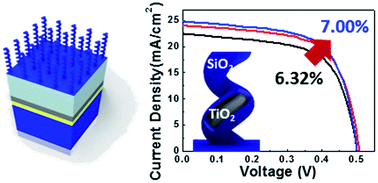Design of novel TiO2–SiO2 core–shell helical nanostructured anti-reflective coatings on Cu(In,Ga)Se2 solar cells with enhanced power conversion efficiency†
Abstract
Introducing an anti-reflective coating (ARC) is the last step of fabricating Cu(In,Ga)Se2 solar cells with enhanced photo-generated current by reducing the reflectance of visible light. The use of nanostructures in ARC has been intensively investigated because this can prolong the optical path length by a scattering effect or by the formation of a refractive index gradient. Herein, we proposed the use of TiO2 helical nanostructures using glancing angle deposition (GLAD), and then synthesized SiO2 surrounding the helical nanostructures to further decrease the reflectance by producing a refractive index gradient. The optimized values of TiO2 and SiO2 thicknesses are 150 nm and 3 nm determined by the finite-difference time-domain (FDTD) simulation on Cu(In,Ga)Se2 solar cells. The suppression of reflectance led to enhanced light absorption across a broad wavelength range, and boosted the JSC from 20.66 to 22.51 mA cm−2, resulting in improved power conversion efficiency (PCE) from 6.32 to 7.00% after applying the TiO2–SiO2 core–shell nanostructures as the ARC. This 10.75% PCE enhancement suggests that the novel TiO2–SiO2 core–shell nanostructures have great potential as ARC for Cu(In,Ga)Se2 solar cells, and it would be beneficial for development in the photovoltaic field in both research and applications.



 Please wait while we load your content...
Please wait while we load your content...